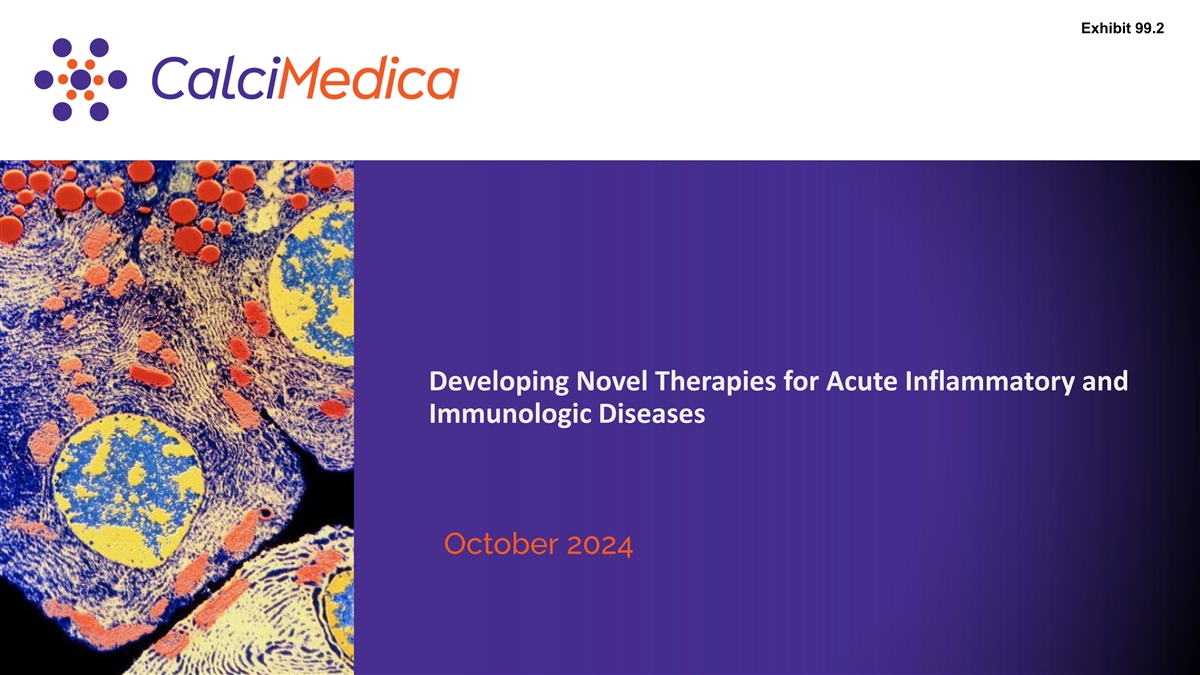
Exhibit 99.2 Developing Novel Therapies for Acute Inflammatory and Immunologic Diseases October 2024 1
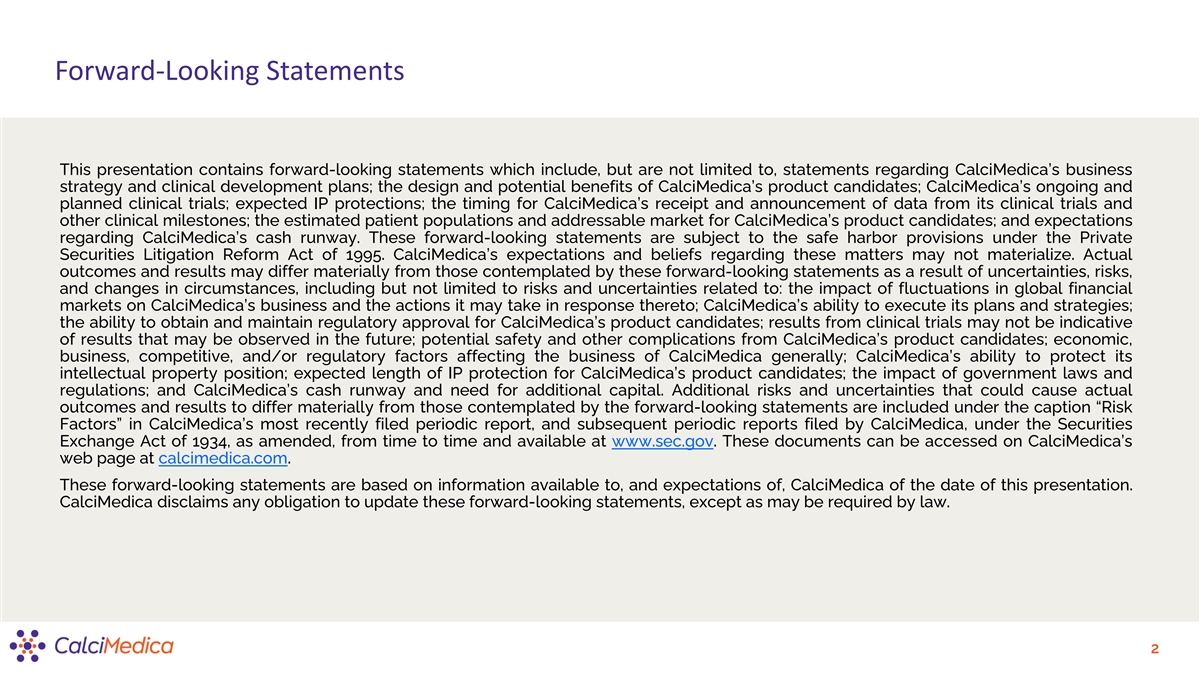
Forward-Looking Statements This presentation contains forward-looking statements which include, but are not limited to, statements regarding CalciMedica’s business strategy and clinical development plans; the design and potential benefits of CalciMedica’s product candidates; CalciMedica’s ongoing and planned clinical trials; expected IP protections; the timing for CalciMedica’s receipt and announcement of data from its clinical trials and other clinical milestones; the estimated patient populations and addressable market for CalciMedica’s product candidates; and expectations regarding CalciMedica’s cash runway. These forward-looking statements are subject to the safe harbor provisions under the Private Securities Litigation Reform Act of 1995. CalciMedica’s expectations and beliefs regarding these matters may not materialize. Actual outcomes and results may differ materially from those contemplated by these forward-looking statements as a result of uncertainties, risks, and changes in circumstances, including but not limited to risks and uncertainties related to: the impact of fluctuations in global financial markets on CalciMedica’s business and the actions it may take in response thereto; CalciMedica’s ability to execute its plans and strategies; the ability to obtain and maintain regulatory approval for CalciMedica’s product candidates; results from clinical trials may not be indicative of results that may be observed in the future; potential safety and other complications from CalciMedica’s product candidates; economic, business, competitive, and/or regulatory factors affecting the business of CalciMedica generally; CalciMedica’s ability to protect its intellectual property position; expected length of IP protection for CalciMedica’s product candidates; the impact of government laws and regulations; and CalciMedica’s cash runway and need for additional capital. Additional risks and uncertainties that could cause actual outcomes and results to differ materially from those contemplated by the forward-looking statements are included under the caption “Risk Factors” in CalciMedica’s most recently filed periodic report, and subsequent periodic reports filed by CalciMedica, under the Securities Exchange Act of 1934, as amended, from time to time and available at www.sec.gov. These documents can be accessed on CalciMedica’s web page at calcimedica.com. These forward-looking statements are based on information available to, and expectations of, CalciMedica of the date of this presentation. CalciMedica disclaims any obligation to update these forward-looking statements, except as may be required by law. 2
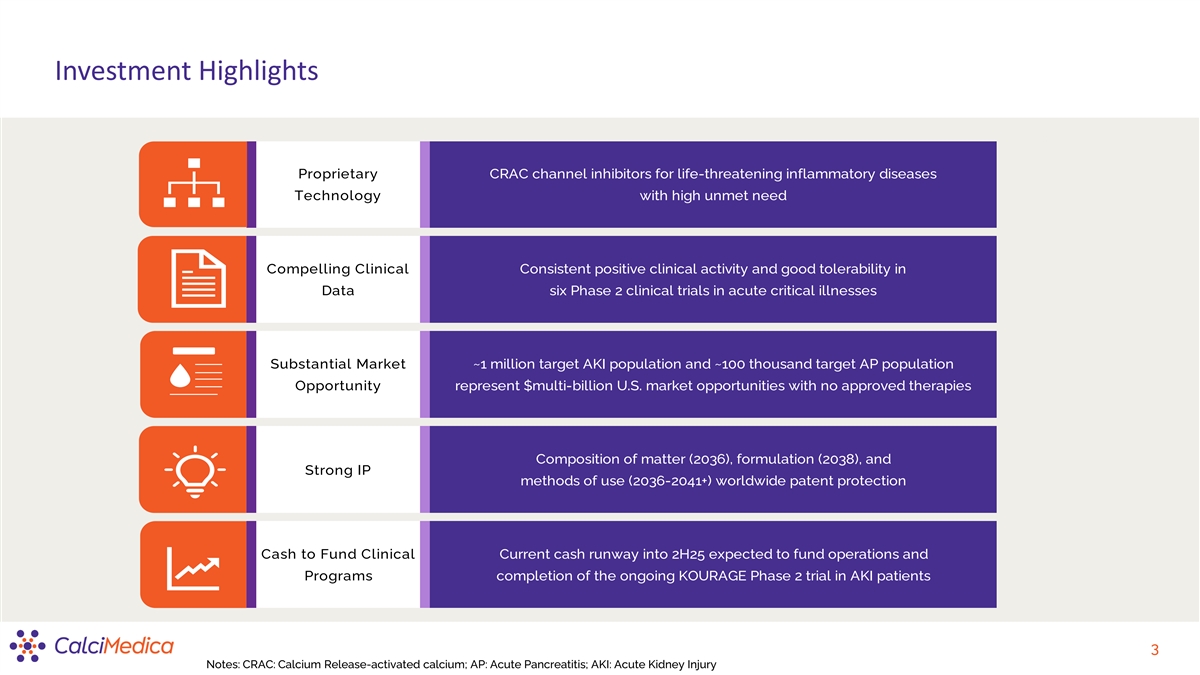
Investment Highlights Proprietary CRAC channel inhibitors for life-threatening inflammatory diseases Technology with high unmet need Compelling Clinical Consistent positive clinical activity and good tolerability in Data six Phase 2 clinical trials in acute critical illnesses Substantial Market ~1 million target AKI population and ~100 thousand target AP population Opportunity represent $multi-billion U.S. market opportunities with no approved therapies Composition of matter (2036), formulation (2038), and Strong IP methods of use (2036-2041+) worldwide patent protection Cash to Fund Clinical Current cash runway into 2H25 expected to fund operations and Programs completion of the ongoing KOURAGE Phase 2 trial in AKI patients 3 Notes: CRAC: Calcium Release-activated calcium; AP: Acute Pancreatitis; AKI: Acute Kidney Injury
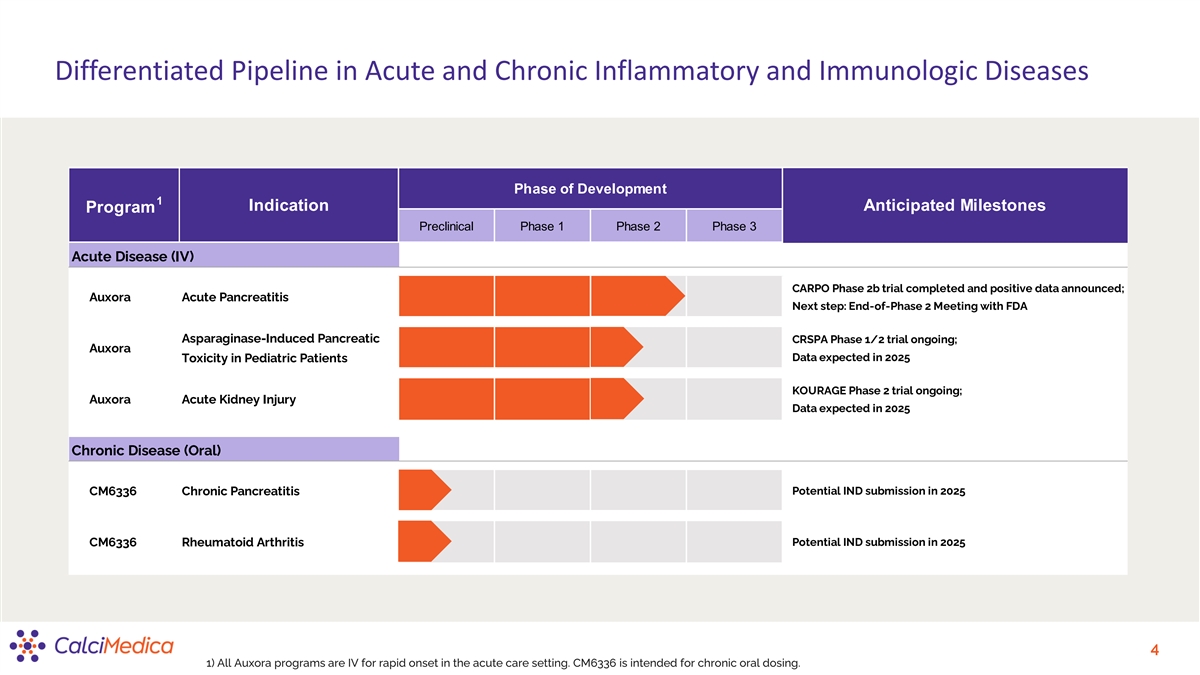
Differentiated Pipeline in Acute and Chronic Inflammatory and Immunologic Diseases Phase of Development 1 Indication Anticipated Milestones Program Preclinical Phase 1 Phase 2 Phase 3 Acute Disease (IV) CARPO Phase 2b trial completed and positive data announced; Auxora Acute Pancreatitis Next step: End-of-Phase 2 Meeting with FDA Asparaginase-Induced Pancreatic CRSPA Phase 1/2 trial ongoing; Auxora Data expected in 2025 Toxicity in Pediatric Patients KOURAGE Phase 2 trial ongoing; Auxora Acute Kidney Injury Data expected in 2025 Chronic Disease (Oral) CM6336 Chronic Pancreatitis Potential IND submission in 2025 CM6336 Rheumatoid Arthritis Potential IND submission in 2025 4 1) All Auxora programs are IV for rapid onset in the acute care setting. CM6336 is intended for chronic oral dosing.
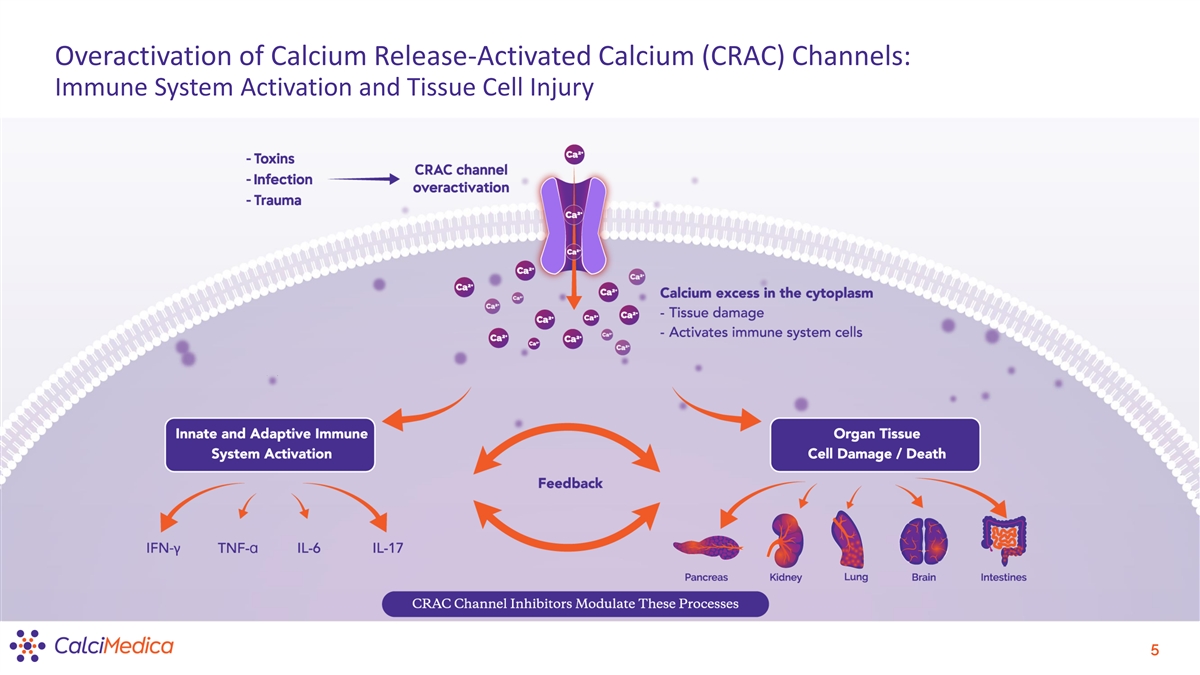
Overactivation of Calcium Release-Activated Calcium (CRAC) Channels: Immune System Activation and Tissue Cell Injury 5
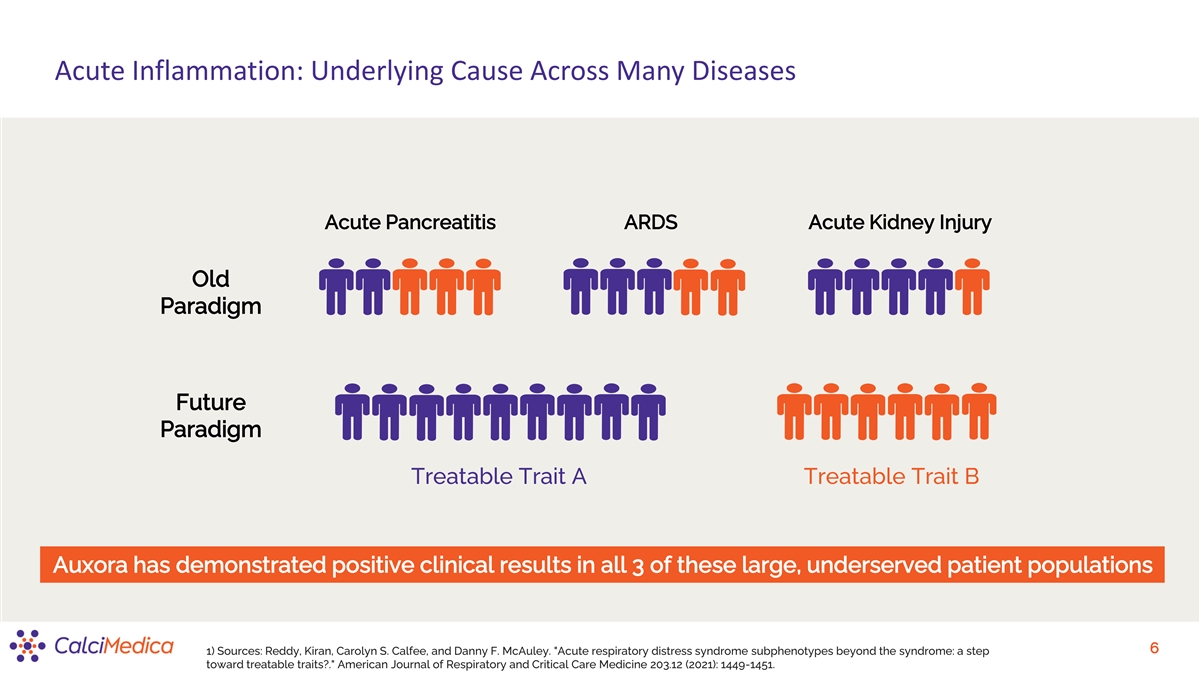
Acute Inflammation: Underlying Cause Across Many Diseases Acute Pancreatitis ARDS Acute Kidney Injury Old Paradigm Future Paradigm Treatable Trait A Treatable Trait B Auxora has demonstrated positive clinical results in all 3 of these large, underserved patient populations 6 1) Sources: Reddy, Kiran, Carolyn S. Calfee, and Danny F. McAuley. Acute respiratory distress syndrome subphenotypes beyond the syndrome: a step toward treatable traits?. American Journal of Respiratory and Critical Care Medicine 203.12 (2021): 1449-1451.
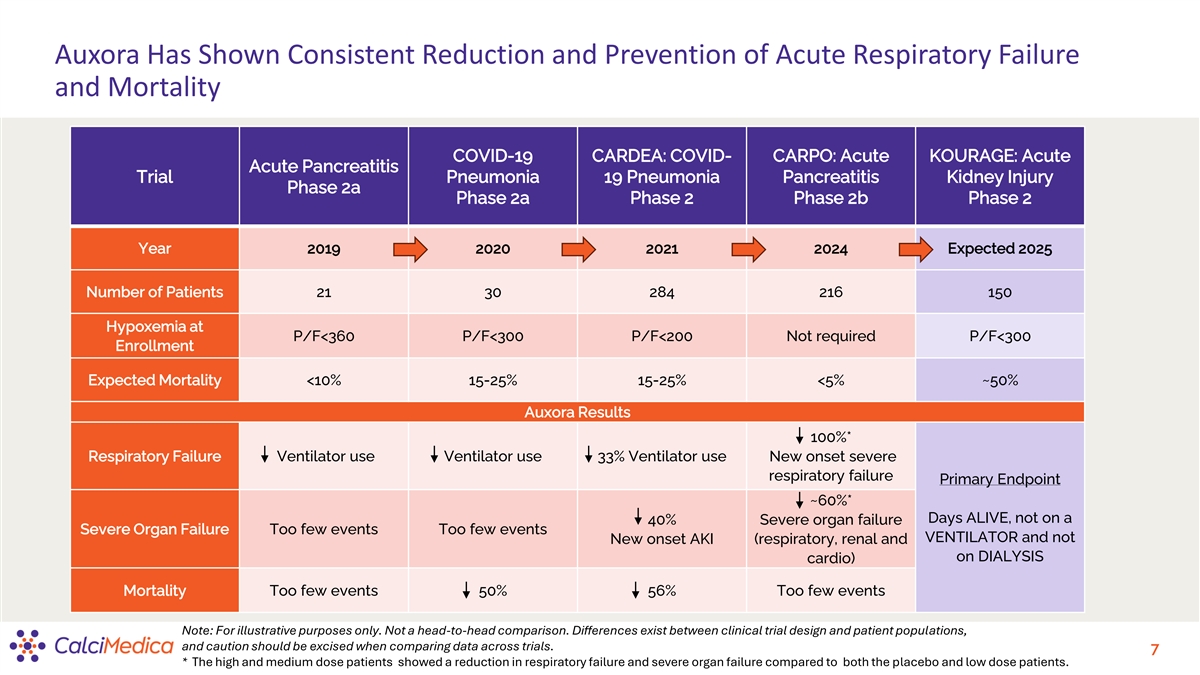
Auxora Has Shown Consistent Reduction and Prevention of Acute Respiratory Failure and Mortality COVID-19 CARDEA: COVID- CARPO: Acute KOURAGE: Acute Acute Pancreatitis Trial Pneumonia 19 Pneumonia Pancreatitis Kidney Injury Phase 2a Phase 2a Phase 2 Phase 2b Phase 2 Year 2019 2020 2021 2024 Expected 2025 Number of Patients 21 30 284 216 150 Hypoxemia at P/F<360 P/F<300 P/F<200 Not required P/F<300 Enrollment Expected Mortality <10% 15-25% 15-25% <5% ~50% Auxora Results 100%* Respiratory Failure Ventilator use Ventilator use 33% Ventilator use New onset severe respiratory failure Primary Endpoint ~60%* Days ALIVE, not on a 40% Severe organ failure Severe Organ Failure Too few events Too few events VENTILATOR and not New onset AKI (respiratory, renal and on DIALYSIS cardio) Mortality Too few events 50% 56% Too few events Note: For illustrative purposes only. Not a head-to-head comparison. Differences exist between clinical trial design and patient populations, and caution should be excised when comparing data across trials. 7 * The high and medium dose patients showed a reduction in respiratory failure and severe organ failure compared to both the placebo and low dose patients.
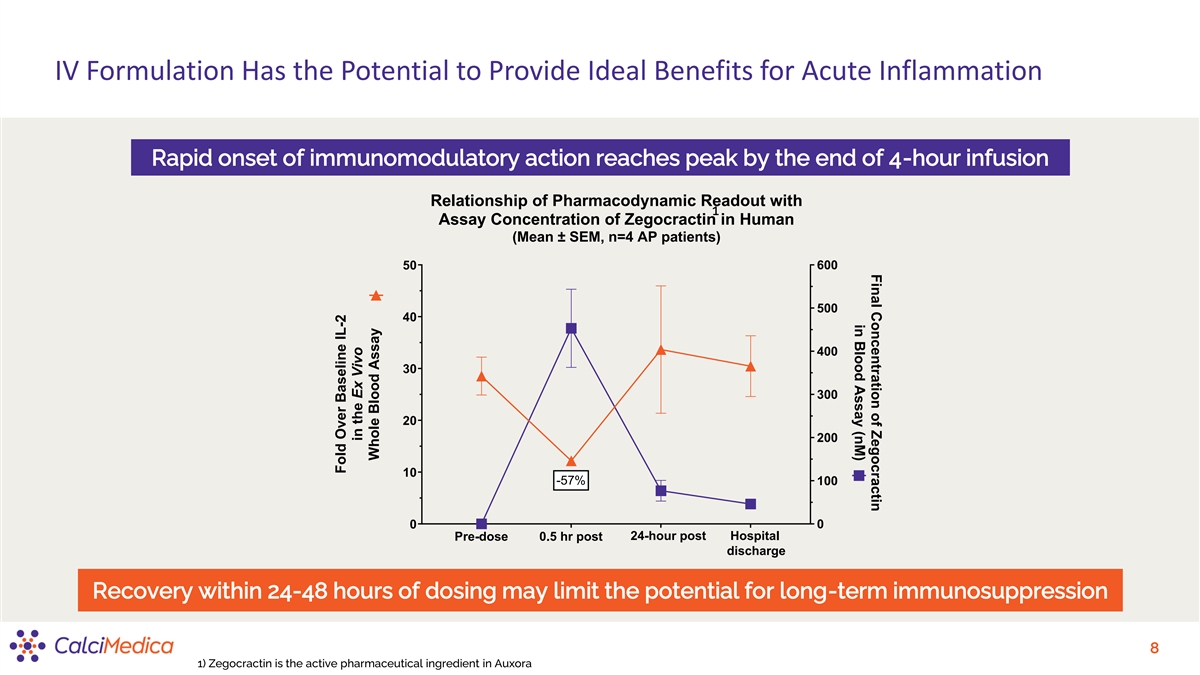
Final Concentration of Zegocractin in Blood Assay (nM) IV Formulation Has the Potential to Provide Ideal Benefits for Acute Inflammation Rapid onset of immunomodulatory action reaches peak by the end of 4-hour infusion Relationship of Pharmacodynamic Readout with 1 Assay Concentration of Zegocractin in Human (Mean ± SEM, n=4 AP patients) 50 600 500 40 400 30 300 20 200 10 -57% 100 0 0 24-hour post Hospital Pre-dose 0.5 hr post Day 2 Discharge discharge Recovery within 24-48 hours of dosing may limit the potential for long-term immunosuppression 8 1) Zegocractin is the active pharmaceutical ingredient in Auxora Fold Over Baseline IL-2 in the Ex Vivo Whole Blood Assay
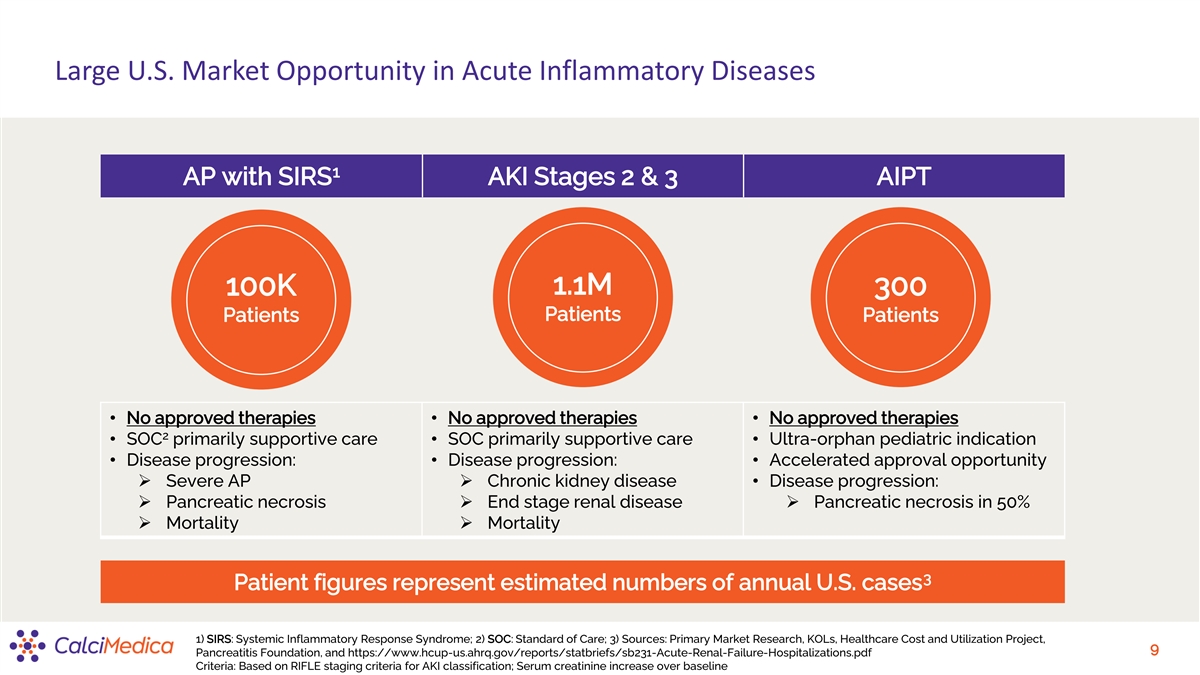
Large U.S. Market Opportunity in Acute Inflammatory Diseases 1 AP with SIRS AKI Stages 2 & 3 AIPT 100K 1.1M 300 Patients Patients Patients • No approved therapies• No approved therapies• No approved therapies 2 • SOC primarily supportive care• SOC primarily supportive care• Ultra-orphan pediatric indication • Disease progression:• Disease progression:• Accelerated approval opportunity ➢ Severe AP➢ Chronic kidney disease• Disease progression: ➢ Pancreatic necrosis➢ End stage renal disease➢ Pancreatic necrosis in 50% ➢ Mortality➢ Mortality 3 Patient figures represent estimated numbers of annual U.S. cases 1) SIRS: Systemic Inflammatory Response Syndrome; 2) SOC: Standard of Care; 3) Sources: Primary Market Research, KOLs, Healthcare Cost and Utilization Project, 9 Pancreatitis Foundation, and https://www.hcup-us.ahrq.gov/reports/statbriefs/sb231-Acute-Renal-Failure-Hospitalizations.pdf Criteria: Based on RIFLE staging criteria for AKI classification; Serum creatinine increase over baseline
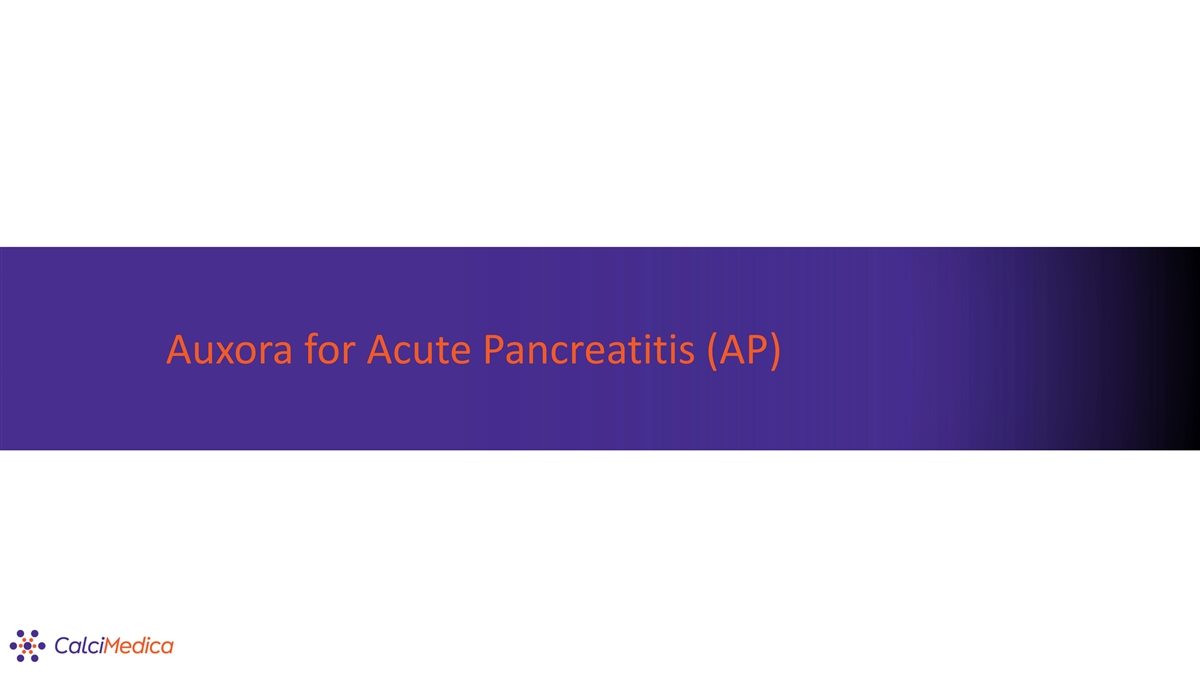
Auxora for Acute Pancreatitis (AP) 10
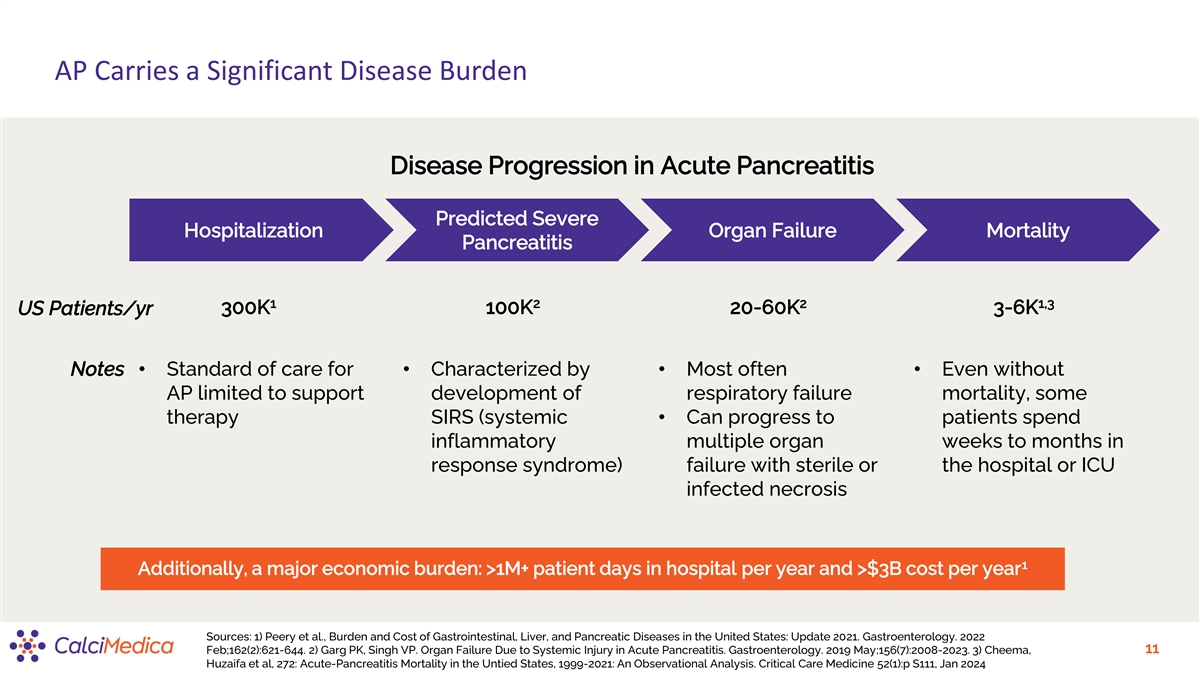
AP Carries a Significant Disease Burden Disease Progression in Acute Pancreatitis Predicted Severe Hospitalization Organ Failure Mortality Pancreatitis 1 2 2 1,3 300K 100K 20-60K 3-6K US Patients/yr Notes• Standard of care for • Characterized by • Most often • Even without AP limited to support development of respiratory failure mortality, some therapy SIRS (systemic • Can progress to patients spend inflammatory multiple organ weeks to months in response syndrome) failure with sterile or the hospital or ICU infected necrosis 1 Additionally, a major economic burden: >1M+ patient days in hospital per year and >$3B cost per year Sources: 1) Peery et al., Burden and Cost of Gastrointestinal, Liver, and Pancreatic Diseases in the United States: Update 2021. Gastroenterology. 2022 Feb;162(2):621-644. 2) Garg PK, Singh VP. Organ Failure Due to Systemic Injury in Acute Pancreatitis. Gastroenterology. 2019 May;156(7):2008-2023. 3) Cheema, 11 Huzaifa et al, 272: Acute-Pancreatitis Mortality in the Untied States, 1999-2021: An Observational Analysis. Critical Care Medicine 52(1):p S111, Jan 2024

Overactive Calcium Release-Activated Calcium (CRAC) Channels Contribute to AP; Auxora, a CRAC Channel Inhibitor, Targets Multiple Pathways Gallstones and excessive alcohol use are the most common causes of AP Acute lung injury and multiple organ failure Bile and fatty acid esters cause 2+ excessive release of Ca in pancreatic acinar cells Auxora CRAC channels are overactive, causing 2+ cellular Ca overload and dysfunction Systemic Inflammatory Response Syndrome (SIRS) Acinar cell autodigestion and necrosis; Ductal cell dysfunction and stellate cell activation Auxora Cascade of pro-inflammatory mediators Auxora (T Cells, Neutrophils, Macrophages) 12 1) Peng S, Ke L, Li W., ORAI1 CRAC Channgel in Immune Cell is a Therapeutic Target for Pancreatitis-Associated Acute Lung Injury. 2023; 2) CalciMedica Inc. CRACing inflammatory disease. 2021.
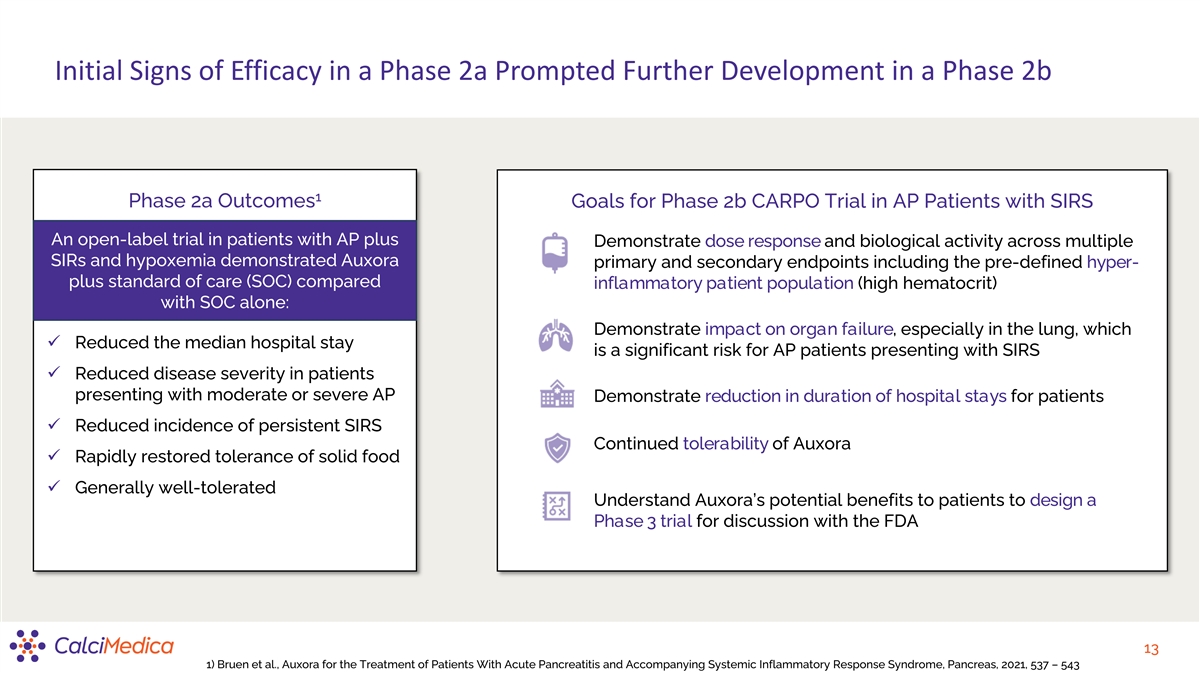
Initial Signs of Efficacy in a Phase 2a Prompted Further Development in a Phase 2b 1 Phase 2a Outcomes Goals for Phase 2b CARPO Trial in AP Patients with SIRS An open-label trial in patients with AP plus Demonstrate dose response and biological activity across multiple SIRs and hypoxemia demonstrated Auxora primary and secondary endpoints including the pre-defined hyper- plus standard of care (SOC) compared inflammatory patient population (high hematocrit) with SOC alone: Demonstrate impact on organ failure, especially in the lung, which ü Reduced the median hospital stay is a significant risk for AP patients presenting with SIRS ü Reduced disease severity in patients presenting with moderate or severe AP Demonstrate reduction in duration of hospital stays for patients ü Reduced incidence of persistent SIRS Continued tolerability of Auxora ü Rapidly restored tolerance of solid food ü Generally well-tolerated Understand Auxora’s potential benefits to patients to design a Phase 3 trial for discussion with the FDA 13 1) Bruen et al., Auxora for the Treatment of Patients With Acute Pancreatitis and Accompanying Systemic Inflammatory Response Syndrome, Pancreas, 2021, 537 – 543
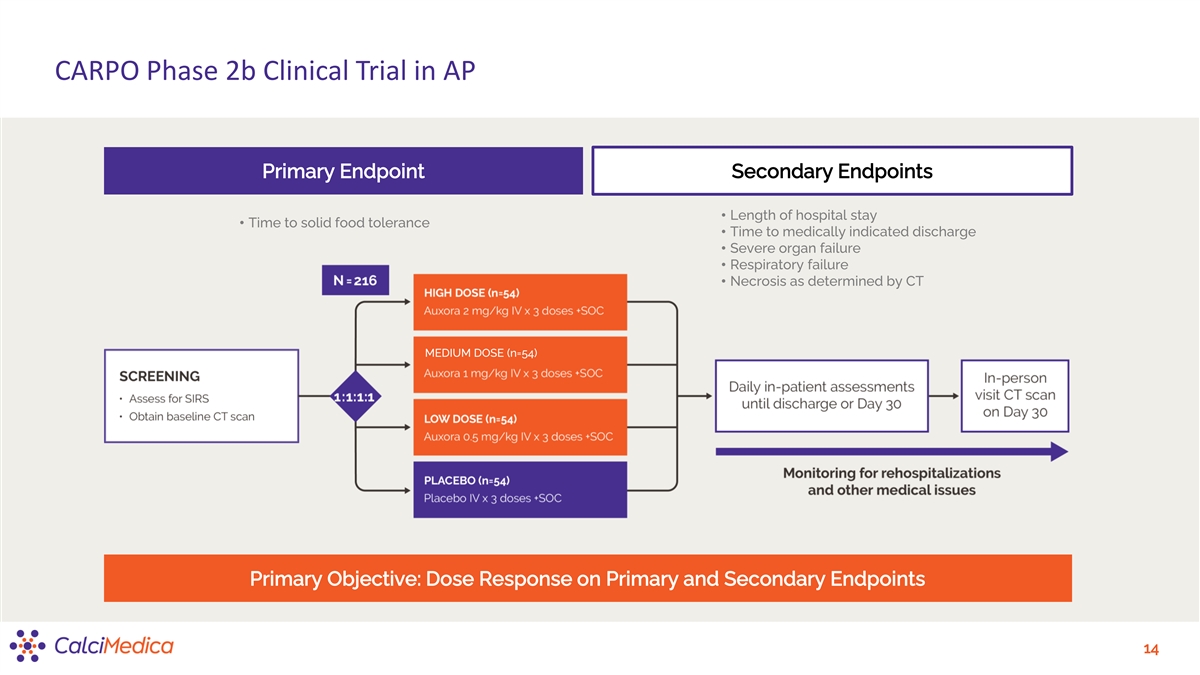
CARPO Phase 2b Clinical Trial in AP Primary Endpoint Secondary Endpoints • Length of hospital stay • Time to solid food tolerance • Time to medically indicated discharge • Severe organ failure • Respiratory failure • Necrosis as determined by CT MEDIUM DOSE (n=54) Primary Objective: Dose Response on Primary and Secondary Endpoints 14

Baseline Characteristics were Generally Aligned Across Groups Baseline Demographics Placebo 0.5 mg/kg 1.0 mg/kg 2.0 mg/kg mITT Population N=53 N=52 N=56 N=53 Median Age 42 (20, 78) 48.5 (23, 85) 43.5 (22, 84) 42 (19, 91) (Minimum, Maximum) Male (%) 33 (62.3) 32 (61.5) 33 (58.9) 33 (62.3) Female (%) 20 (37.7) 20 (38.5) 23 (41.1) 20 (37.7) High Hematocrit (% of N) 20 (37.7) 24 (46) 25 (44.6) 23 (43.4) ( > 44 males, > 40 females) Any Respiratory Failure (%) 6 (11.3) 4 (7.6) 4 (7.1) 3 (5.6) Readable Necrotizing 1/53 (1.9) 4/51 (7.8) 3/56 (5.3) 4/49 (8.1) Pancreatitis (%) Note: mITT was 214 patients as 2 enrolled patients did not receive study drug Patients were recruited across 37 sites in both the US and India 15 mITT, modified intention-to-treat; N, number
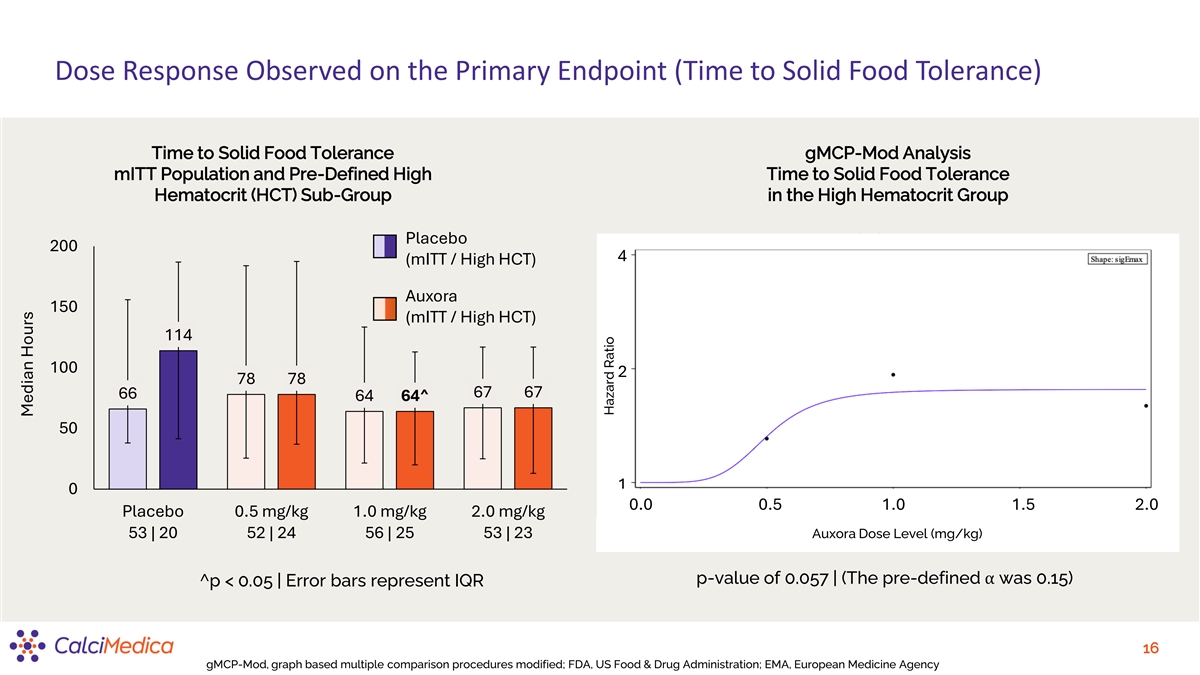
Dose Response Observed on the Primary Endpoint (Time to Solid Food Tolerance) Time to Solid Food Tolerance gMCP-Mod Analysis mITT Population and Pre-Defined High Time to Solid Food Tolerance Hematocrit (HCT) Sub-Group in the High Hematocrit Group Placebo 200 4 (mITT / High HCT) Auxora 150 (mITT / High HCT) 114 100 2 78 78 67 67 66 64 64^ 50 1 0 0.0 0.5 1.0 1.5 2.0 Placebo 0.5 mg/kg 1.0 mg/kg 2.0 mg/kg 53 | 20 52 | 24 56 | 25 53 | 23 Auxora Dose Level (mg/kg) p-value of 0.057 | (The pre-defined α was 0.15) ^p < 0.05 | Error bars represent IQR 16 gMCP-Mod, graph based multiple comparison procedures modified; FDA, US Food & Drug Administration; EMA, European Medicine Agency Median Hours Hazard Ratio

Auxora High and Medium Doses Reduced All Types of Severe Organ Failure Severe Organ Failure Placebo 0.5 mg/kg 1.0 mg/kg 2.0 mg/kg N=53 N=52 N=56 N=53 Respiratory 4/53 (7.5%) 5/52 (9.6%) 2/56 (3.6%) 2/53 (3.8%) Renal 1/53 (1.9%) 2/52 (3.8%) 1/56 (1.8%) 0/53 (0.0%) Cardiovascular 1/53 (1.9%) 3/52 (5.8%) 1/56 (1.8%) 1/53 (1.9%) Any Severe Organ Failure 5/53 (9.4%) 5/52 (9.6%) 2/56 (3.6%) 2/53 (3.8%) Severe Respiratory Failure: Receiving invasive mechanical ventilation (IMV) OR use of either high flow nasal cannula (HFNC) or non-invasive mechanical ventilation (NIMV) for ≥ 48 hours Severe Renal Failure: Initiation of renal replacement therapy Severe Cardiovascular Failure: Use of vasopressor or inotropic support for ≥48 hours 17

Dose Response was Observed for both New Onset Persistent & Severe Respiratory Failure Reduced New Onset Persistent Respiratory Failure Prevented New Onset Severe Respiratory Failure Placebo 0.5 mg/kg 1.0 mg/kg 2.0 mg/kg Placebo 0.5 mg/kg 1.0 mg/kg 2.0 mg/kg New Onset Persistent 8/47 5/48 1/52 4/50 New Onset Severe 4/47 4/48 0/52 0/50 Respiratory Failure (17.0%) (10.4%) (1.9%) (8%) Respiratory Failure (8.5%) (8.3%) (0%) (0%) Placebo + 0.5 mg/kg 1.0 mg/kg + 2.0 mg/kg Placebo + 0.5 mg/kg 1.0 mg/kg + 2.0 mg/kg New Onset Persistent 13/95 5/102 New Onset Severe 8/95 0/102 Respiratory Failure (13.7%) (4.9%) Respiratory Failure (8.4%) (0%) Difference -8.8 % Difference -8.4 % Relative Reduction 64.2% Relative Reduction 100% p-value 0.0476 p-value 0.0027 Respiratory failure: Severe Respiratory Failure: • P/F ≤300 by arterial blood gas or imputed from pulse oximetry • Receiving invasive mechanical ventilation (IMV); OR • Use of either high flow nasal cannula (HFNC) or non-invasive mechanical Persistent respiratory failure was defined as either: ventilation (NIMV) for ≥ 48 hours • Severe respiratory failure; OR • Not Severe: P/F ≤300 for 48 hours, but no use of ventilatory support other than low flow oxygen 18 Differences were calculated using Cochran-Mantel-Haenszel test stratified by CRF recorded gender (male or female) and the risk for hematocrit (HCT) (higher or lower) based on CRF data
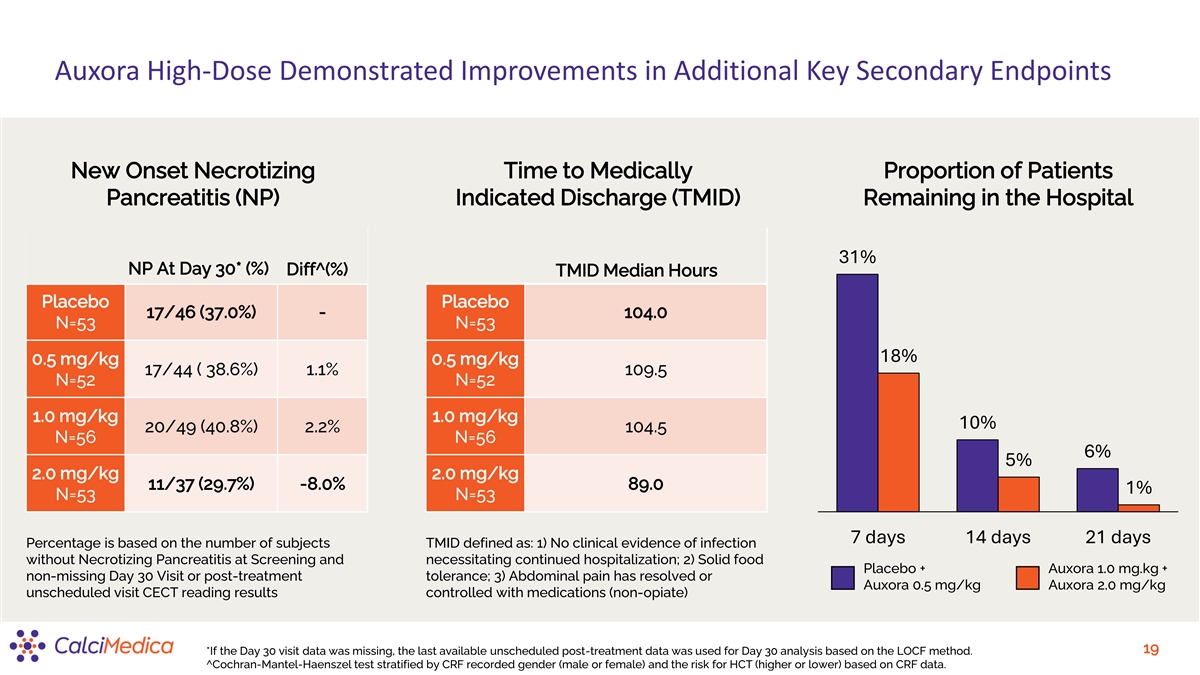
Auxora High-Dose Demonstrated Improvements in Additional Key Secondary Endpoints New Onset Necrotizing Time to Medically Proportion of Patients Pancreatitis (NP) Indicated Discharge (TMID) Remaining in the Hospital NP At Day 30* (%) Diff^(%) TMID Median Hours 31% NP At Day 30* (%) Diff^(%) TMID Median Hours Placebo Placebo 17/46 (37.0%) - 104.0 N=53 N=53 18% 0.5 mg/kg 0.5 mg/kg 17/44 ( 38.6%) 1.1% 109.5 N=52 N=52 1.0 mg/kg 1.0 mg/kg 10% 20/49 (40.8%) 2.2% 104.5 N=56 N=56 6% 5% 2.0 mg/kg 2.0 mg/kg 11/37 (29.7%) -8.0% 89.0 1% N=53 N=53 7 days 14 days 21 days Percentage is based on the number of subjects TMID defined as: 1) No clinical evidence of infection without Necrotizing Pancreatitis at Screening and necessitating continued hospitalization; 2) Solid food Placebo + Auxora 1.0 mg.kg + non-missing Day 30 Visit or post-treatment tolerance; 3) Abdominal pain has resolved or Auxora 0.5 mg/kg Auxora 2.0 mg/kg unscheduled visit CECT reading results controlled with medications (non-opiate) 19 *If the Day 30 visit data was missing, the last available unscheduled post-treatment data was used for Day 30 analysis based on the LOCF method. ^Cochran-Mantel-Haenszel test stratified by CRF recorded gender (male or female) and the risk for HCT (higher or lower) based on CRF data.
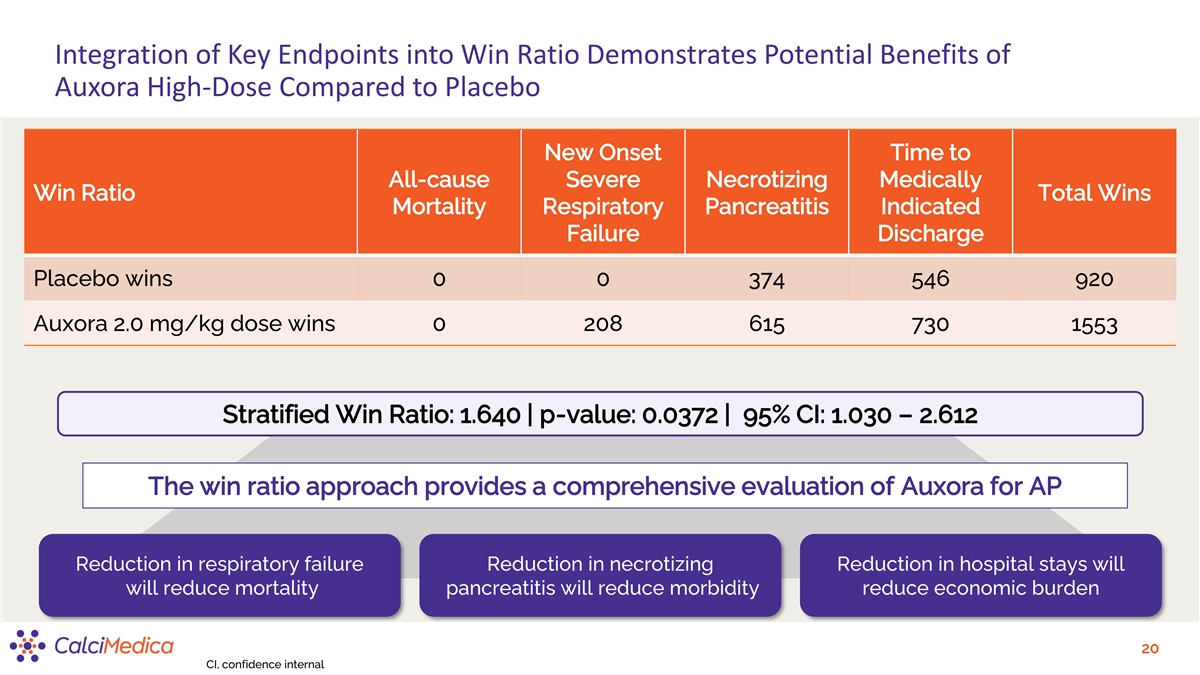
Integration of Key Endpoints into Win Ratio Demonstrates Potential Benefits of Auxora High-Dose Compared to Placebo New Onset Time to All-cause Severe Necrotizing Medically Win Ratio Total Wins Mortality Respiratory Pancreatitis Indicated Failure Discharge Placebo wins 0 0 374 546 920 Auxora 2.0 mg/kg dose wins 0 208 615 730 1553 Stratified Win Ratio: 1.640 | p-value: 0.0372 | 95% CI: 1.030 – 2.612 The win ratio approach provides a comprehensive evaluation of Auxora for AP Reduction in respiratory failure Reduction in necrotizing Reduction in hospital stays will will reduce mortality pancreatitis will reduce morbidity reduce economic burden 20 CI, confidence internal

Overall, Auxora Was Well Tolerated with Few Discontinuations Across all Doses and No Related TESAEs or Deaths for the High Dose Group Safety Summary: Placebo 0.5 mg/kg 1.0 mg/kg 2.0 mg/kg Number of Patients N=53 N=52 N=56 N=53 At least one TEAE leading to 3 (5.7) 2 (3.8) 2 (3.6) 2 (3.8) discontinuation of study drug (%) At least one related TESAE (%) 0 1 (1.9) 0 0 TEAE leading to death (%) 1 (1.9) 0 1 (1.8) 0 At least one TEAE (%) 25 (47.2) 28 (53.8) 36 (64.3) 23 (43.4) At least one related TEAE (%) 5 (9.4) 9 (17.3) 6 (10.7) 4 (7.5) At least one TESAE (%) 6 (11.3) 3 (25.0) 12 (21.4) 8 (15.1) 21 N, total patient population; TEAE, treatment emergent adverse event; TESAE, treatment emergent serious adverse event
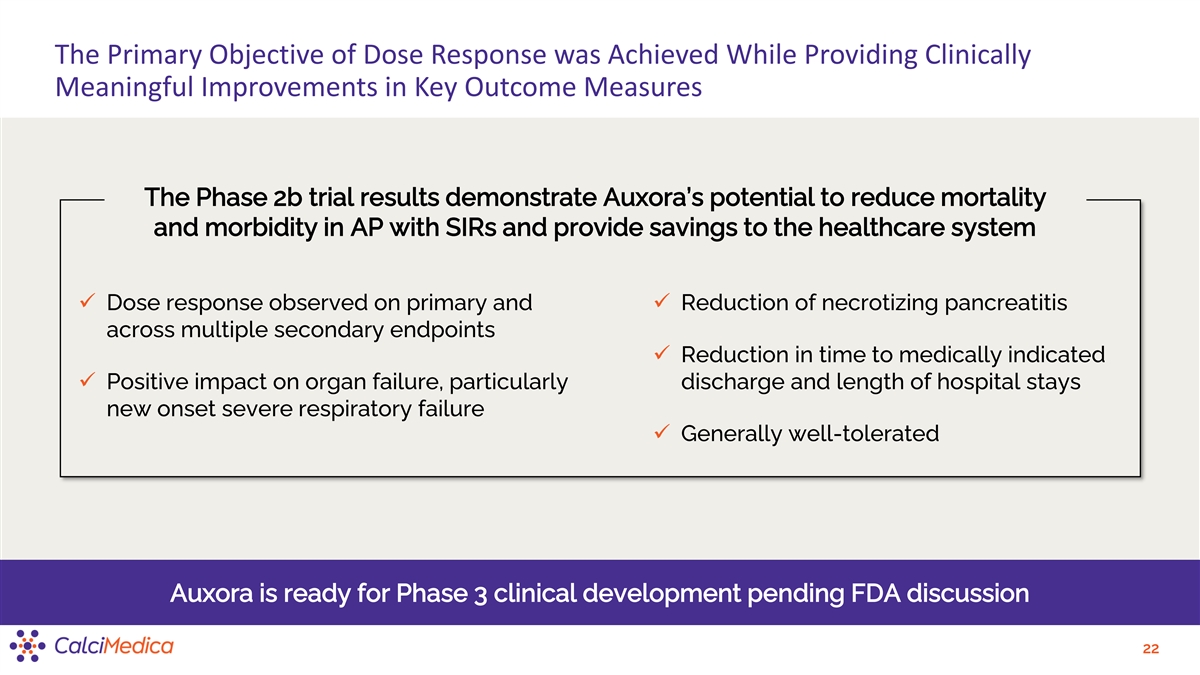
The Primary Objective of Dose Response was Achieved While Providing Clinically Meaningful Improvements in Key Outcome Measures The Phase 2b trial results demonstrate Auxora’s potential to reduce mortality and morbidity in AP with SIRs and provide savings to the healthcare system ✓ Dose response observed on primary and ✓ Reduction of necrotizing pancreatitis across multiple secondary endpoints ✓ Reduction in time to medically indicated ✓ Positive impact on organ failure, particularly discharge and length of hospital stays new onset severe respiratory failure ✓ Generally well-tolerated Auxora is ready for Phase 3 clinical development pending FDA discussion 22

Auxora for Asparaginase-Induced Pancreatic Toxicity (AIPT) in Pediatric Patients 23
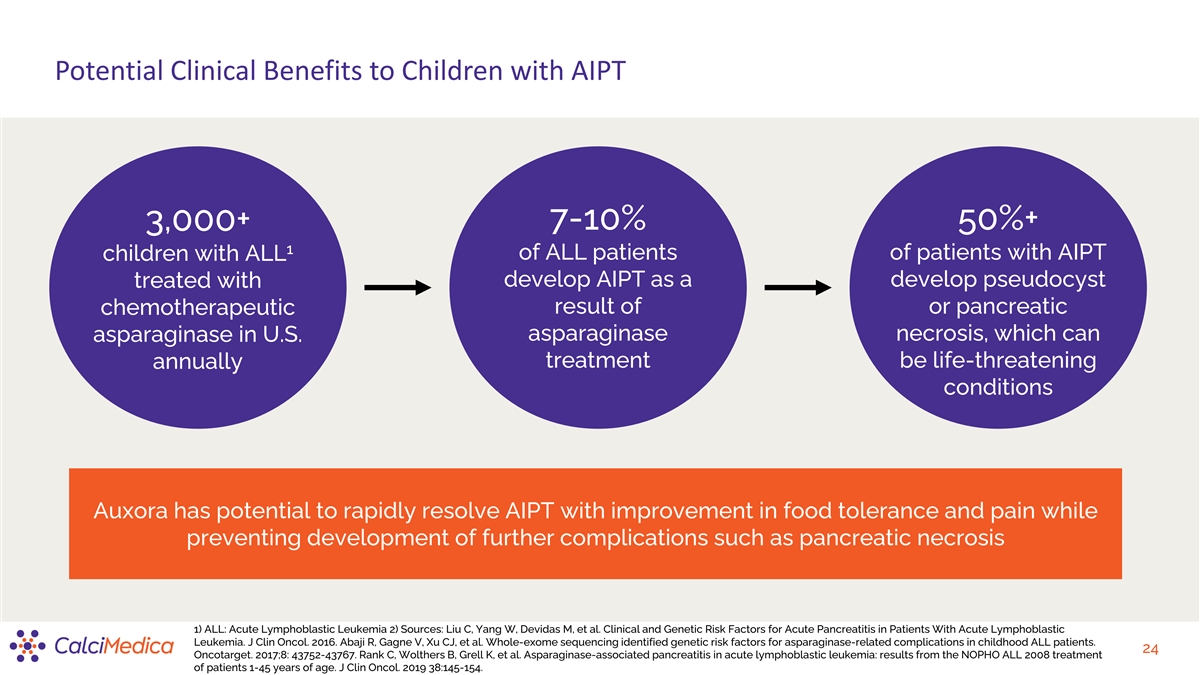
Potential Clinical Benefits to Children with AIPT 7-10% 50%+ 3,000+ 1 of ALL patients of patients with AIPT children with ALL treated with develop AIPT as a develop pseudocyst result of or pancreatic chemotherapeutic asparaginase necrosis, which can asparaginase in U.S. treatment be life-threatening annually conditions Auxora has potential to rapidly resolve AIPT with improvement in food tolerance and pain while preventing development of further complications such as pancreatic necrosis 1) ALL: Acute Lymphoblastic Leukemia 2) Sources: Liu C, Yang W, Devidas M, et al. Clinical and Genetic Risk Factors for Acute Pancreatitis in Patients With Acute Lymphoblastic Leukemia. J Clin Oncol. 2016. Abaji R, Gagne V, Xu CJ, et al. Whole-exome sequencing identified genetic risk factors for asparaginase-related complications in childhood ALL patients. 24 Oncotarget. 2017;8: 43752-43767. Rank C, Wolthers B, Grell K, et al. Asparaginase-associated pancreatitis in acute lymphoblastic leukemia: results from the NOPHO ALL 2008 treatment of patients 1-45 years of age. J Clin Oncol. 2019 38:145-154.
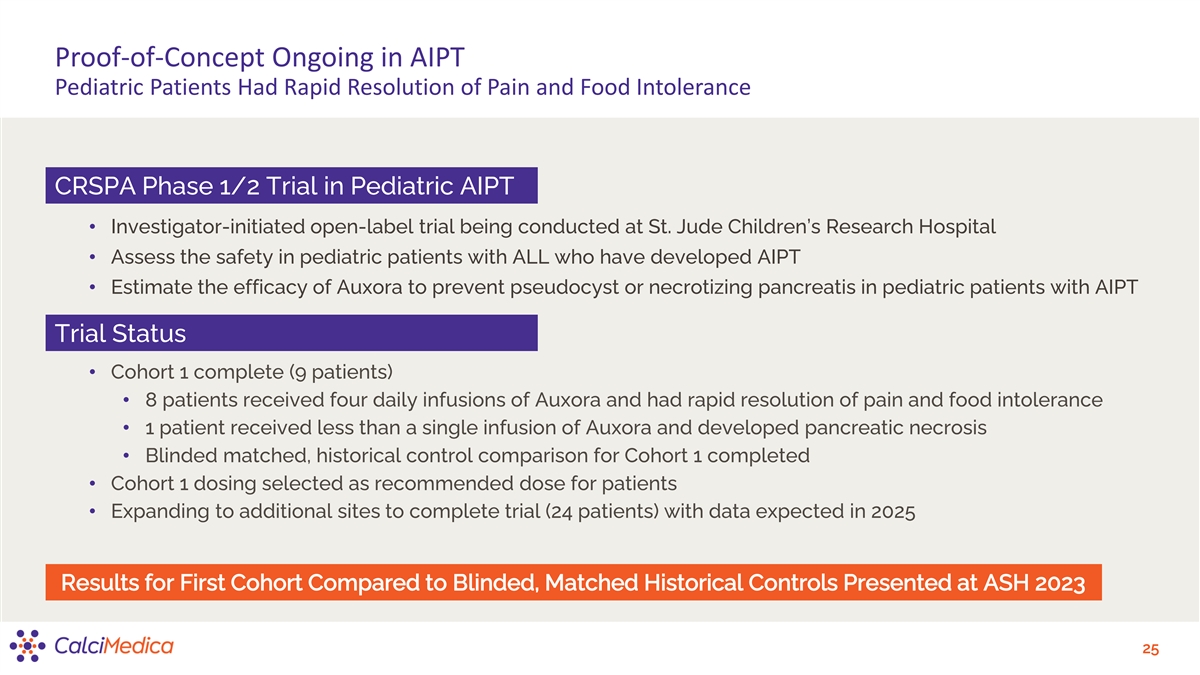
Proof-of-Concept Ongoing in AIPT Pediatric Patients Had Rapid Resolution of Pain and Food Intolerance CRSPA Phase 1/2 Trial in Pediatric AIPT • Investigator-initiated open-label trial being conducted at St. Jude Children’s Research Hospital • Assess the safety in pediatric patients with ALL who have developed AIPT • Estimate the efficacy of Auxora to prevent pseudocyst or necrotizing pancreatis in pediatric patients with AIPT Trial Status • Cohort 1 complete (9 patients) • 8 patients received four daily infusions of Auxora and had rapid resolution of pain and food intolerance • 1 patient received less than a single infusion of Auxora and developed pancreatic necrosis • Blinded matched, historical control comparison for Cohort 1 completed • Cohort 1 dosing selected as recommended dose for patients • Expanding to additional sites to complete trial (24 patients) with data expected in 2025 Results for First Cohort Compared to Blinded, Matched Historical Controls Presented at ASH 2023 25
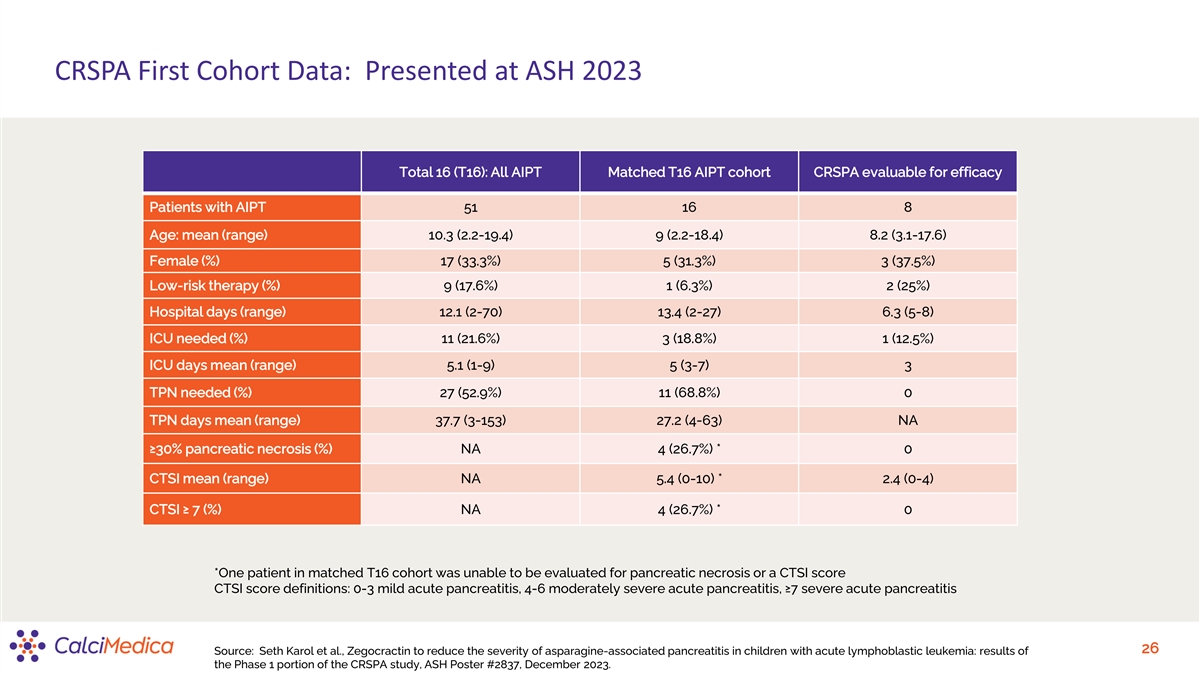
CRSPA First Cohort Data: Presented at ASH 2023 Total 16 (T16): All AIPT Matched T16 AIPT cohort CRSPA evaluable for efficacy Patients with AIPT 51 16 8 Age: mean (range) 10.3 (2.2-19.4) 9 (2.2-18.4) 8.2 (3.1-17.6) Female (%) 17 (33.3%) 5 (31.3%) 3 (37.5%) Low-risk therapy (%) 9 (17.6%) 1 (6.3%) 2 (25%) Hospital days (range) 12.1 (2-70) 13.4 (2-27) 6.3 (5-8) ICU needed (%) 11 (21.6%) 3 (18.8%) 1 (12.5%) ICU days mean (range) 5.1 (1-9) 5 (3-7) 3 TPN needed (%) 27 (52.9%) 11 (68.8%) 0 TPN days mean (range) 37.7 (3-153) 27.2 (4-63) NA ≥30% pancreatic necrosis (%) NA 4 (26.7%) * 0 CTSI mean (range) NA 5.4 (0-10) * 2.4 (0-4) CTSI ≥ 7 (%) NA 4 (26.7%) * 0 *One patient in matched T16 cohort was unable to be evaluated for pancreatic necrosis or a CTSI score CTSI score definitions: 0-3 mild acute pancreatitis, 4-6 moderately severe acute pancreatitis, ≥7 severe acute pancreatitis 26 Source: Seth Karol et al., Zegocractin to reduce the severity of asparagine-associated pancreatitis in children with acute lymphoblastic leukemia: results of the Phase 1 portion of the CRSPA study, ASH Poster #2837, December 2023.
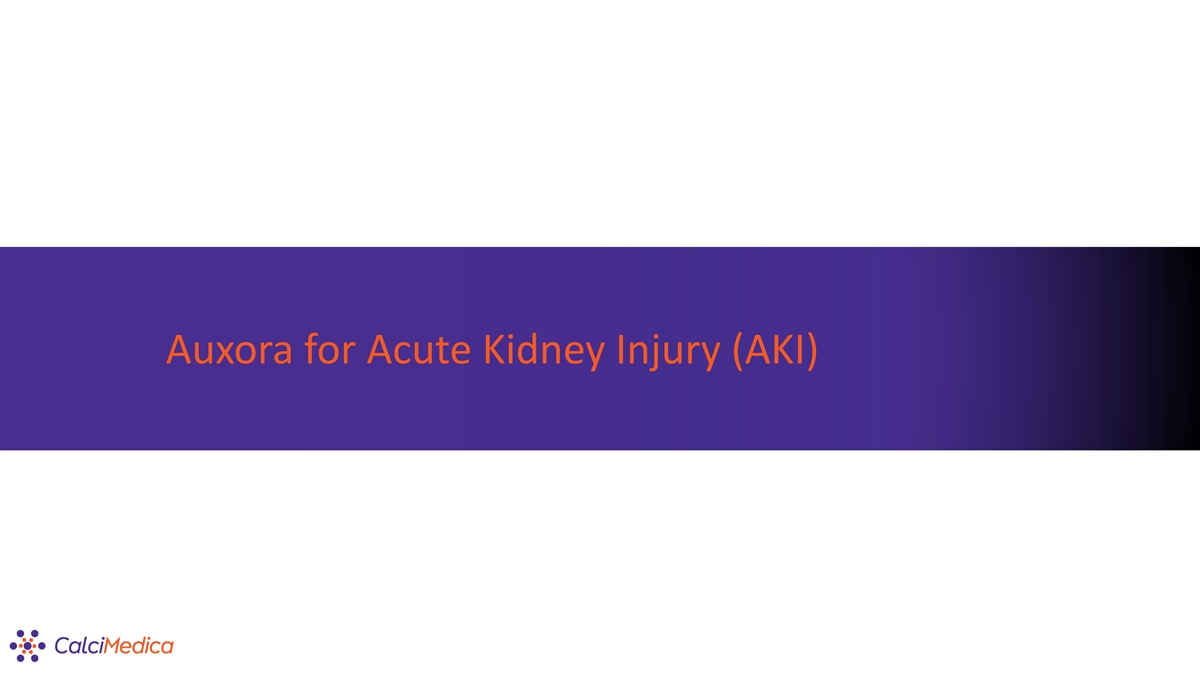
Auxora for Acute Kidney Injury (AKI) 27

Patient Journey in AKI Disease Progression without Early Intervention Post Injury 7 Days 90 Days Acute Chronic End-stage AKI Kidney Disease Kidney Disease Renal Disease ~3.7M AKI hospitalizations annually (U.S.) 71% 17% 12% Stage 2 Stage 1 Stage 3 2 ↑ sCr 2x ↑ sCr 1.5x↑ sCr 3x 1 Auxora Target Market: 1.1M Patients Over half of these patients have respiratory failure with 90-day mortality 50% or greater 1) Source: https://www.hcup-us.ahrq.gov/reports/statbriefs/sb231-Acute-Renal-Failure-Hospitalizations.pdf 28 Criteria: Based on RIFLE staging criteria for AKI classification; Serum creatinine increase over baseline 2) sCr: Serum Creatinine

Potential Clinical Benefits to Patients with AKI Current standard of care is • Fluid resuscitation / Diuretics • Nutrition limited to supportive • Correction of underlying cause therapy • Reduced need for dialysis Potential Benefits of • Reduced risk of respiratory failure Auxora • Reduced risk of mortality • Greater recovery of renal function 29

Auxora Improved Kidney Recovery and Survival in Severe AKI models Three doses of Auxora or placebo were administered daily starting 6 hours after ischemia/reperfusion injury 30 Note: GFR is Glomerular filtration rate and data is courtesy of David Basile, PhD, Indiana University

Evidence of Renal Protection: Phase 2 CARDEA Trial Ang-2/Tie2 results in endothelial inflammation with Ang-1/Tie2 signaling maintains vascular integrity increased endothelial permeability Angiopoietin-2 Levels Angiopoietin-1 Levels Decrease Significantly with Auxora Increase Significantly with Auxora (Means ± SEM) (Means ± SEM) 250 8000 1 ns* p=0.01 1 p=0.01 0 6000 -250 4000 ns* -500 2000 -750 0 -1000 -2000 Placebo Auxora Placebo Auxora Clinical Observations • Mortality benefit with Auxora vs Placebo observed in patients with compromised kidney function (low GFR) at time of enrollment • ~40% reduction in reported AKI with Auxora vs Placebo 31 Change in Angiopoietin-1 from Screening to 96 hours (pg/mL) Change in Angiopoietin-2 from Screening to 96 hours (pg/mL)
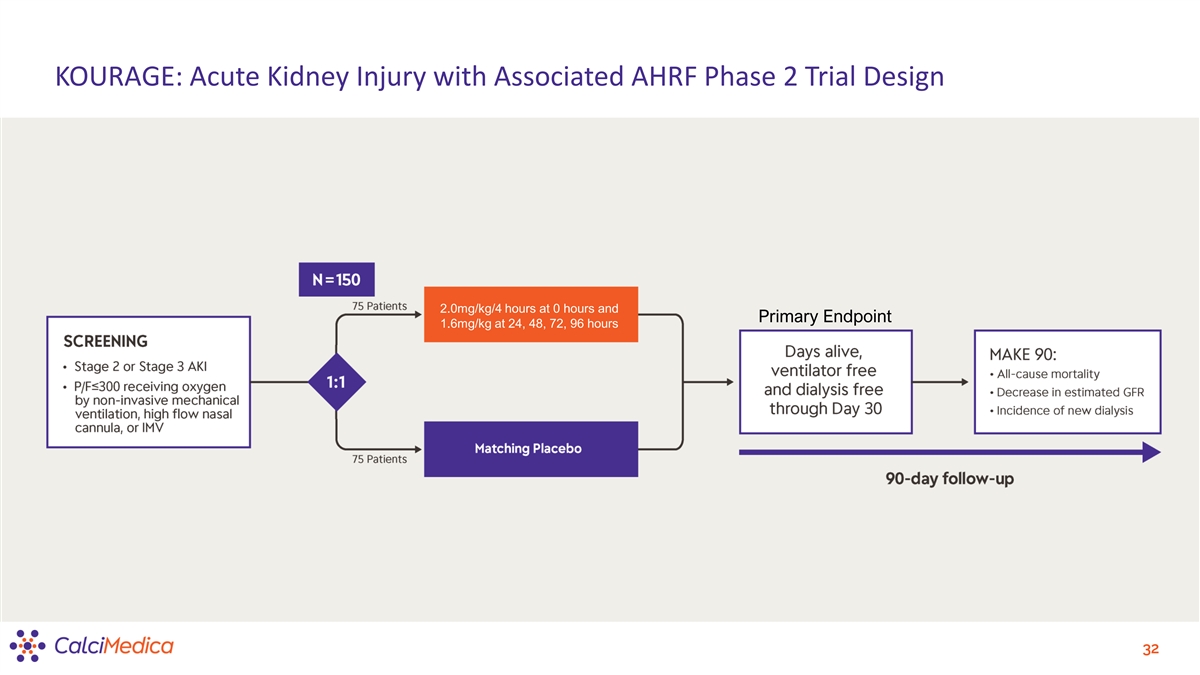
KOURAGE: Acute Kidney Injury with Associated AHRF Phase 2 Trial Design 2.0mg/kg/4 hours at 0 hours and Primary Endpoint 1.6mg/kg at 24, 48, 72, 96 hours 32
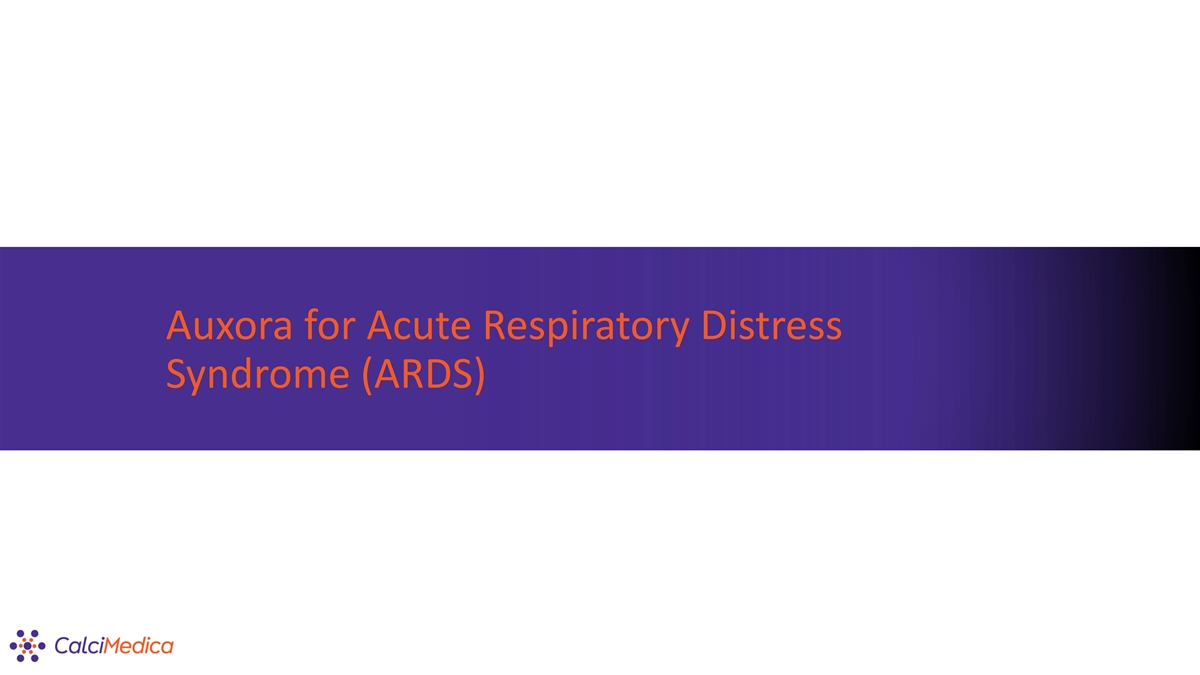
Auxora for Acute Respiratory Distress Syndrome (ARDS) 33
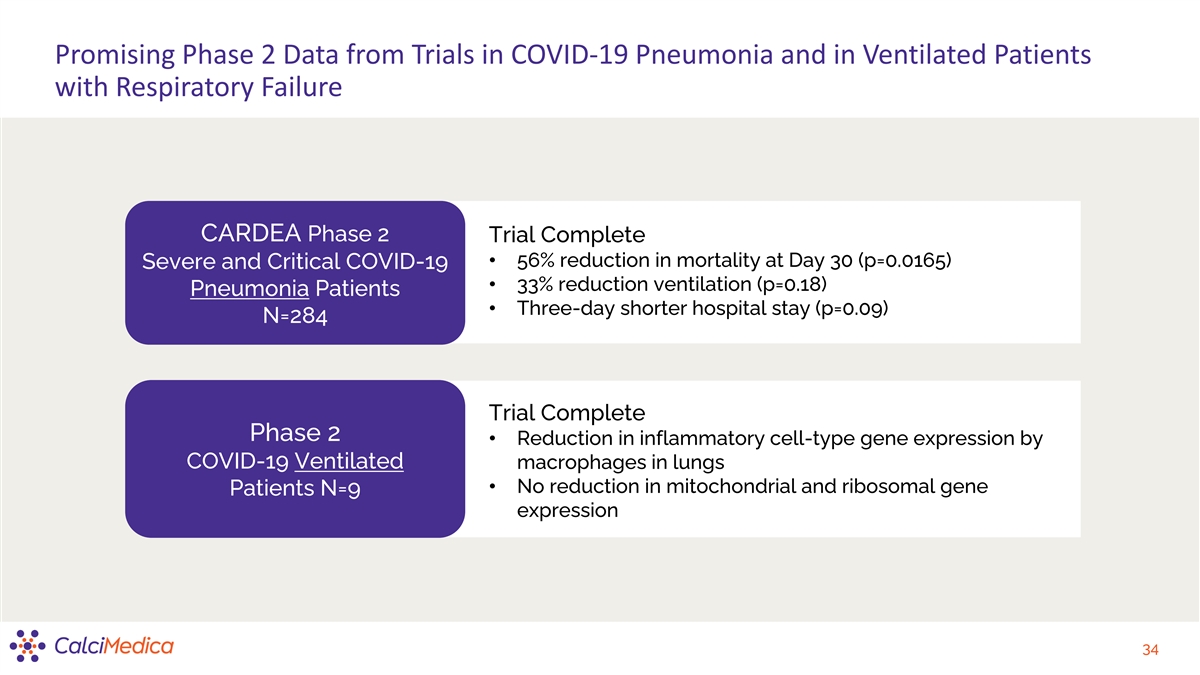
Promising Phase 2 Data from Trials in COVID-19 Pneumonia and in Ventilated Patients with Respiratory Failure CARDEA Phase 2 Trial Complete • 56% reduction in mortality at Day 30 (p=0.0165) Severe and Critical COVID-19 • 33% reduction ventilation (p=0.18) Pneumonia Patients • Three-day shorter hospital stay (p=0.09) N=284 Trial Complete Phase 2 • Reduction in inflammatory cell-type gene expression by COVID-19 Ventilated macrophages in lungs • No reduction in mitochondrial and ribosomal gene Patients N=9 expression 34

Platform Application for CRAC Channel Inhibition 35

Preclinical Results Supporting Other I&I Indications Intended Indication Preclinical Observations Next Steps Formulation In vivo efficacy in a mouse model of CP Chronic Oral using CM5480 Confirm with lead oral candidate Pancreatitis (CP) (Szabo et al, 2023) In vivo efficacy of zegocractin in a Acute Ulcerative Ongoing discussions with investigators IV mouse model of inflammatory bowel about potential clinical trials Colitis disease (Letizia et al., 2022) In vivo efficacy of zegocractin in a IV or Inhaled mouse model of allergic asthma Pursue strategic partnership Allergic Asthma (Kahlfuss et al., 2022) In vivo efficacy of CM5480 in a mouse Traumatic Brain Confirm results with lead oral compound IV or Oral model of TBI or Auxora Injury (TBI) (Mizuma et al., 2018) In vivo efficacy of zegocractin and Rheumatoid Oral CM5480 in rat RA models (CalciMedica Confirm results with lead oral candidate Arthritis (RA) unpublished data) 36
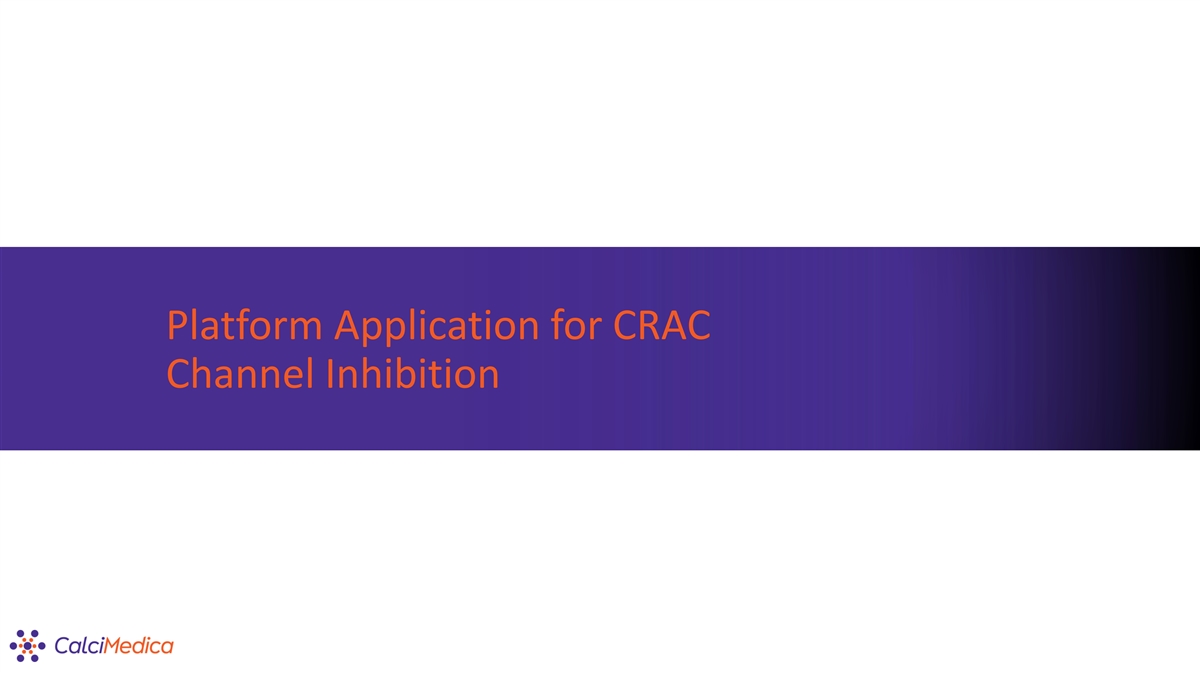
Platform Application for CRAC Channel Inhibition 37
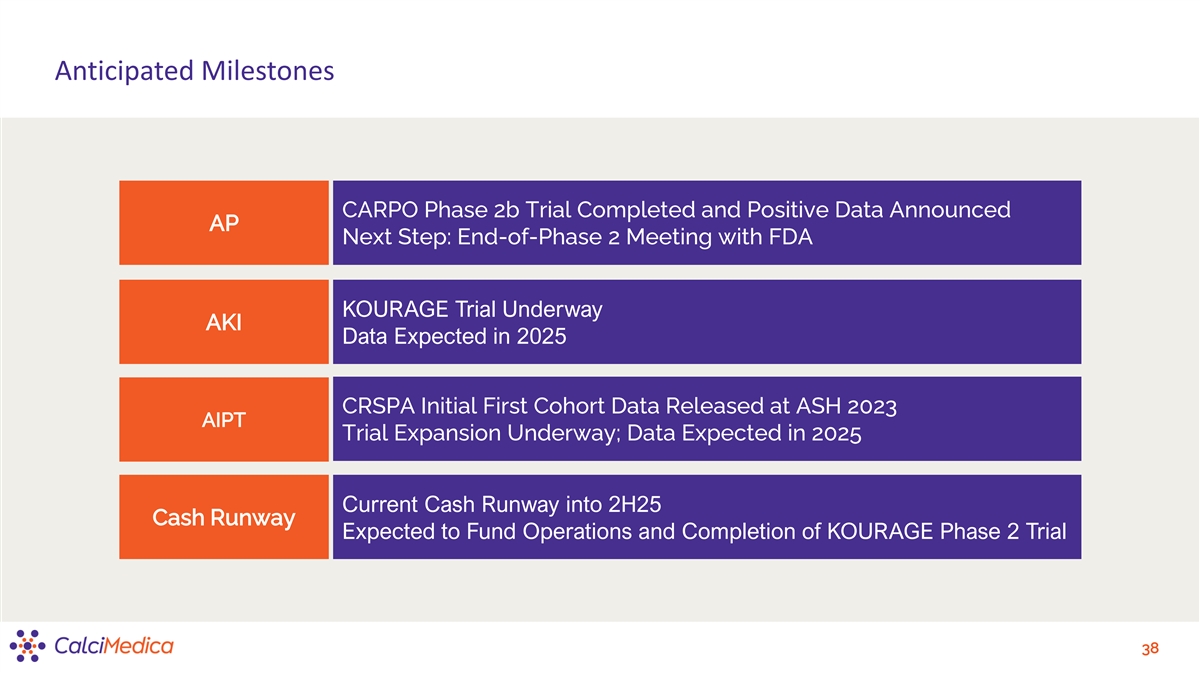
Anticipated Milestones CARPO Phase 2b Trial Completed and Positive Data Announced AP Next Step: End-of-Phase 2 Meeting with FDA KOURAGE Trial Underway AKI Data Expected in 2025 CRSPA Initial First Cohort Data Released at ASH 2023 AIPT Trial Expansion Underway; Data Expected in 2025 Current Cash Runway into 2H25 Cash Runway Expected to Fund Operations and Completion of KOURAGE Phase 2 Trial 38





































